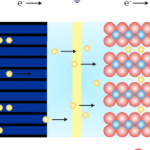Purpose of This Note:
This application note discusses electrochemical measurements on lithium ion batteries. Theory and general setup of lithium ion batteries are explained. Important parameters for characterizing batteries are described.
In addition, various experiments on coin cells are performed. They show how to gain information about a battery’s performance, e.g. capacity and voltage limits as well as long time behavior.
Introduction
Batteries are indispensable energy storage systems for mobile and stationary applications. They are mostly used for portable devices or when electrical lines are impractical or impossible.
Their application fields reach from smaller devices such as MP3 players or smartphones up to high power systems for the automotive market or energy storage systems for power plants, e.g. wind power plants.
Setup
The typical setup of batteries consists of two oppositely charged electrodes which are separated by an electrolyte. They can be classified as primary or secondary cells, depending on their chemical system.
Primary cells
Primary batteries can not be recharged. They are already fully charged and can be used immediately. They offer high specific energies and long storage times.
However, primary cells cover currently only a niche market. They are in general used when rechargeable batteries are impractical or charging is not possible, e.g. watches, toys, or pacemaker. Other applications fields can be found in the military, e.g. missiles.

Typical primary cells are alkaline manganese, zinc-carbon or lithium batteries.
Secondary cells
In contrast to primary cells, secondary batteries can be recharged hundreds of times. Their market share increases steadily.
The oldest rechargeable battery is the lead acid battery which is still used as starter battery in vehicles or for back up systems. Other examples are nickel cadmium (NiCd), nickel metal hydride (NiMH), or lithium ion batteries. Latter one is currently in the focus of research as it is the battery of choice for the automotive market.
Read complete application note at Gamry.com
